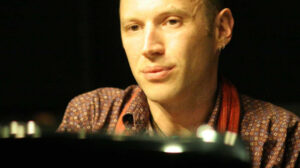ARTIST BIO Filippo started coding generative projects for 8-bit computers at the age of 10 in the early 1980s, with polyphonic music expressed in hertz and milliseconds, and images created in hexadecimal data. Following a formal education in visual arts and music, he worked as a traditional designer, visual artist, and musician while expressing […]
ARTIST BIO Filippo started coding generative projects for 8-bit computers at the age of 10 in the early 1980s, with polyphonic music expressed in hertz and milliseconds, and images created in hexadecimal data. Following a formal education in visual arts and music, he worked as a traditional designer, visual artist, and musician while expressing […]

ARTIST BIO
Filippo started coding generative projects for 8-bit computers at the age of 10 in the early 1980s, with polyphonic music expressed in hertz and milliseconds, and images created in hexadecimal data.
Following a formal education in visual arts and music, he worked as a traditional designer, visual artist, and musician while expressing his creative talents in a more technological form. In the early 1990s, he founded “Alpha Channel,” Italy’s first interactive media creative agency. During those years, he had been a pioneer in connecting the arts and technology in Italy and abroad. In 1993 he founded “NeT-ArT”, one of the first, if not the first, online integrated art projects. In 1996, the jury of Mediartech, Florence’s Multimedia Opera Festival, chaired by Gillo Pontecorvo, awarded him first place for the “Virtual Tour” project.
After that, he established ForteYang, an international award-winning creative interactive agency. While at ForteYang, he was able to present his transdisciplinary vision of authoring music, visuals, algorithms, and interactive experiences for clients in Europe, the United States, and Asia.
He also wrote music and performed all over Italy with the iconic band CONTROMANO in the 1990s and early 2000s. He left the agency (and the band) in 2004 and relocated to China to pursue a solo artist and consultant career. He collaborated with creative agencies all over the world on highly innovative interactive projects, and his musical works have been featured in films and the arts, as well as released by international record labels.
While developing algorithms to replicate human behavior for decision-making for the gaming industry, his interest in generative art increased. He developed the “Amrita” concept, algorithm, and technology over the past two decades, perfecting an artificial artistic intelligence capable of simulating human complexity in audio-visual creation. He was inspired by his work on artificial beings as well as by his experience as a pianist improviser and fine artist. His works of art have been exhibited internationally in solo and group exhibitions.
With Amrita, he performs on the harmonium both locally and internationally. He also just released the first-ever “app artwork” that is available in app stores.
At Naples’ Suor Orsola Benincasa University, he also takes great pleasure in teaching students a range of disciplines, from transdisciplinary creativity to digital experiences technology.
ARTIST’S STATEMENT
I’ve spent my life creating music, visual art, concepts, narration, interactive experiences, and performing on stage as a vocalist and pianist. All these expressive means have been adjudicated by the passion for technology and creative coding. After mastering music instruments and visual arts techniques, I have found the same, if not a higher, amount of creative possibilities in the beauty and elegance of algorithms and code.
During the last two decades, I have perfected the artificial artistic intelligence named Amrita, the Sanskrit term for “nectar of immortality.” Whatever Amrita creates is impermanent, and cannot be repeated. Once Amrita is invoked, a new entity is brought to life. Once the machine is switched off, Amrita dies, along with its consciousness, creations, and experiences.
Amrita works with images, sounds, music scores, and directives created by human artists. Amrita gets to know the boundaries of the hardware it is living within, and learns while creating, evolving over time.
My living artworks, among other possibilities, can create visuals, music, and communicate with each other, living on site specific installations or on users’ devices, opening up the intertwined possibilities of human and artificial complexity.
My exploration is technological, artistic, and narrative. The objective is to expand the idea of artwork and performance to embrace the limitless possibilities given by the modern relationship between humans and machines—and between humans through machines—in addition to producing captivating narratives, visual arts, installations, and music. I also explore the interaction between human and artificial artists in live performances where musicians are led by the AI creative process.
Instead of using technology and code to simply produce art, I work to instil the creative possibilities of an artist into artificial beings, free to evolve independently and to create compelling experiences on their own, driven by a distinct personality. My creatures are living, impermanent artworks, that grow a unique consciousness and develop over time towards a new awareness and new creative possibilities.
With my work, I also wish to stimulate a connection with our deep, ancestral, innate awareness of impermanence. Furthermore, I wish to bring the obscure, alienating sides of technology back into the light; for this reason, I call my performances “Trans-human Yoga”, and I duet with the AI on the harmonium, an ancient sacred instrument.
The final artwork ecosystems include performances, installations, musical compositions, visual artworks, site-specific works, and NFTs.
I’m also looking into the concept of “App Artwork,” which takes advantage of the potential of application stores (like the Apple Store or Google Play Store) to deliver artworks that live, operate, and interact with users, as well as with other similarly conceived works of art. This is because of the widespread use of smartphones and tablets and the resulting reliance on the computing power and network accessibility of modern handheld devices.
The release of “Ad Vitam,” the first ever artwork application to be offered through official stores, represented a major milestone in the research process.